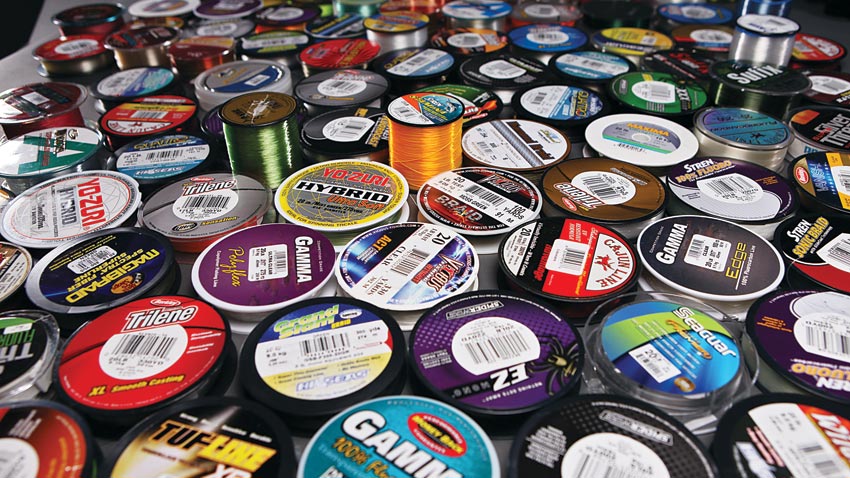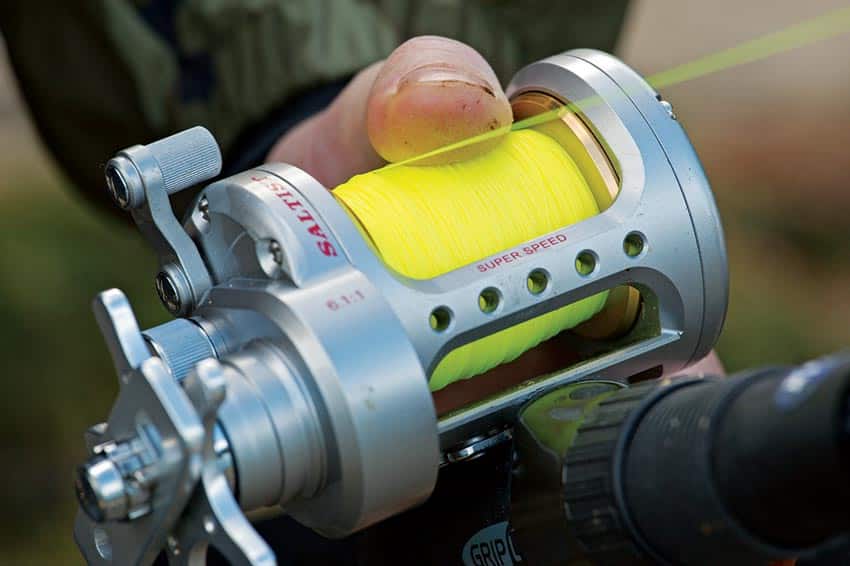
We fishermen chat endlessly about the latest lures, flashiest reels and prettiest boats on the market. These subjects are just plain cool and, as humans, we’re naturally drawn to the excitement of things like powerful outboard engines and big treble hooks.
But what about the types of fishing line? Unfortunately, many anglers overlook this important segment of tackle. They shouldn’t.
The line, after all, connects us with our favorite lures and baits, transferring energies and rod-tip manipulations from hands to hooks. It also serves as the vital link once a fish is successfully stuck.
In short, line matters. And in an era marked by tremendous innovation in fishing equipment across the board, perhaps no other category has experienced a greater explosion of technological advances and improvements than lines.
Nylon-based monofilaments, polyethylene braids and crystalline fluorocarbon products provide line choices for all types of fishing. And if you’re not up-to-speed on the subject, you’re probably not fishing to your potential.

Monofilament: An Oldie but a Goodie
Of course, all anglers are familiar with monofilament. For more than 60 years, these nylon-based lines have reigned supreme. It’s little wonder. Monofilament offers many fishing attributes that anglers like.
It is generally soft and supple — knots draw tight and secure with very little slippage or burning. It provides good abrasion resistance and maintains sound breaking strength. Monofilament also stretches, an advantage in many fishing situations.
Still, there is no perfect mono.
“To get one of those desirable qualities,” explains Chuck Gerlach, owner of Ande Monofilament, “you usually give up another to a certain degree. There’s always a give and take.”
Gerlach knows of what he speaks. His father bought Ande in 1968, and the company’s lines have become longtime favorites among many die-hard anglers. The give-and-take Gerlach refers to is determined by how a monofilament is constructed.
The term “monofilament” is actually something of a misnomer. Yes, the final product we fish with is basically a single filament, but it results from a complex mixture of multiple nylon-based polymers of different molecular compositions. These parts begin as pellets and are sorted to exacting quantities, according to a manufacturer’s patented “recipe.” They’re melted down, mixed together in hoppers and pulled through an extruder, creating a copolymer, single-strand line.
“The entire process probably spans 250 feet (on the factory floor),” Gerlach says. “It then goes through various rolls and ovens that operate at different speeds and temperatures. They pull the nylon to the proper diameter.”
These diameters coincide with breaking strengths, and as the line cures, it begins to take on the characteristics determined by that original recipe. Perhaps the mono will be soft, like a Berkley Trilene XL. Or maybe it will be tougher and more abrasion resistant, like an XT. Then again, it could be one of the new premium monos, such as Trilene XL Armor Coated, a coextruded monofilament built with two bonded layers that features a soft inner core and a hard outer layer.
Technological advances such as this coextrusion process — coupled with mono’s rich history and affordability — have kept the line in the hands of many anglers.
“It’s still by far the biggest segment of line sold,” says Clay Norris, senior product manager for fishing lines at Pure Fishing, makers of Berkley, Stren and Spiderwire. “It’s more than half.”
But mono doesn’t hold all the answers. Nylon absorbs water, and if a monofilament has been submerged for 24 hours, it reaches a saturation point and begins to break down.
“It can lose up to 30 percent of its strength,” says John DeVries, vice president of sales and marketing at Seaguar. “It’s been a great line over the years, but it’s not always the best fishing line for every situation.”
Fluorocarbon: The Magical Vanishing Line
What monofilament doesn’t always deliver, fluorocarbon can. Fluoro might appear like mono at first blush — but it’s vastly different.
Both stretch, but fluoro is less pliable, and it does not absorb water like mono. It also repels chemicals and ultraviolet light, and will not turn brittle in cold temperatures. Spill some sunscreen or gasoline on a spool of mono, and you’ve got a potential problem. But do the same on a spool of fluoro, and there’s nary a worry.
Produced through a chemical-bonding and extrusion process involving fluorine, carbon and hydrogen, a finished fluorocarbon product is a downright tough line! It is dense in composition and generally three times heavier than mono, which means it also sinks three times as fast.
But it’s fluorocarbon’s unique ability to refract light — instead of reflecting it — that serves as its greatest attribute.
Or, in layman’s terms, “it’s totally invisible underwater,” says Steve Miller, sales director for American Fishing Wire, which produces Hi-Seas fluorocarbon products.
It was this quality that attracted anglers in droves to fluoro when it first popped up in the American marketplace in the early to mid-1990s. Those initial fluorocarbon lines, which stemmed from Japan, were extremely rigid and abrasion resistant, which was good for some fishing purposes, but anglers quickly discovered that tying knots in fluoro was infinitely more difficult than with mono.
Knot strength remains an issue, though evolving fluoro technologies have brought vast improvements. “Once you cinch it, it’s fine,” says Norris, noting that lubricating fluorocarbon is critical to avoid line disintegration. “It doesn’t have quite the strength of the strongest nylons, but it’s definitely in the range of many.”
DeVries touts Seaguar’s proprietary double-structure fluorocarbons, which make use of two different resins — one pliable and one rigid. When extruded, a single-structure line is produced, featuring a soft core covered by a protective exterior.

Other manufacturers continue to elevate the category as well. George Large, executive vice president at Yo-Zuri, says that when a fluorocarbon line is nicked, light is often transmitted and amplified through that imperfection. But the company’s proprietary Power Carbon fluoro leaders have eliminated this trait.
“It’s a huge advantage to not spooking fish,” Large says.
In salt water, anglers primarily use fluorocarbon as leader material, but a recent gravitation among freshwater anglers from monofilament to fluoro main lines begs the question as to whether the same could happen in the coastal and offshore markets. Though some saltwater anglers have experimented with fluoro main line, the product still has its drawbacks, including its high price.
More likely, a growing trend will continue to swell.
“It’s all about fluorocarbon leaders and braids these days,” says Ted Sakai, product manager for PowerPro. “That’s really the direction things will continue to move. There are just so many different applications.”
Braid: The Newest Game in Town
Indeed, the combination of fluorocarbon leaders matched with nonstretch braids has proved effective, even revolutionary, in dozens of fishing applications. But the extent of what’s happening today runs even deeper.
The emergence of these lines ignited nothing short of a sea change in fishing gear. As line technologies rapidly evolved, rod and reel design raced to keep up, prompting massive evolution in both categories.
This might seem like a lot of fuss over a little line. But, then again, braid is no ordinary line.

All braided fishing lines begin with a synthetic thermoplastic known as polyethylene. Through a process called gel-spinning, this raw material is processed into razor-thin, spider-weblike fibers known as Dyneema or Spectra (see Braided Lined Defined).
These fibers, also called carriers, contain dozens of microfilaments and are extraordinarily strong. When woven together with other carriers on a braiding machine — voila! — you create a braid’s core.
Extremely thin yet incredibly strong, these braided structures then enter the highly guarded coating process. And it’s here, according to Rex Nelson, president of Western Filament, that braided-line technology has truly blossomed.

Nelson should know. His company, founded in 1938 and currently operating 4,500 braiding machines, produced “the first braided fishing line made from Spectra in 1991,” he says, “and then built Spiderwire from 1993 to 1996.”
Coatings were largely a trial-and-error experiment in those days, Nelson says. “You had to find something with adhesive properties — and even the engineers were scratching their heads at first.”
Bryan Yamane, assistant product manager for fishing lines and accessories at Daiwa, maker of Saltiga and Samurai braids, remembers that era well. “Some of the original lines had a really rough feel,” Yamane says. “You could hear the lines hiss on the guides.”
But things quickly improved, and manufacturers honed their coating technologies. Western Filament, which currently manufacturers Tuf-Line products, settled on a synthetic, bicomponent elastomer that the company uses to this day; and Nelson notes that a 4-, 6- or 8-carrier braid with 18 to 22 pics per inch (points at which the carriers intersect) is optimal on most standard braids built for conventional reels.
Spinning reels are another matter. They’re best served with what’s known as a fused braid, such as a Berkley Fireline. What’s the difference between the two? The braids are, well, fused.
“You can get the molecular construction of the fibers to change at about 220 to 240 degrees F,” Nelson explains. “The raw materials begin to fuse or melt together when treated with heat.”
This process allows for the creation of lines that are much more supple, and less likely to tangle and form wind knots. Industry insiders agree that much evolution is just around the corner for the fused category.
For that matter, anything’s possible these days, even the creation of a new category. At press time, Berkley was releasing its new, Dyneema-based Nanofil, a line that could prove to fit the bill.

Says Norris: “The future is wide open with possibilities.”
And that’s no line.








